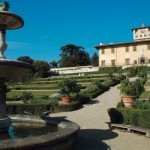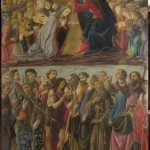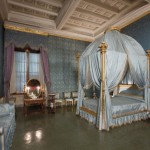Villa della Petraia is rightfully considered one of the most beautiful Medici villas.
Originally, it was the property of the Brunelleschi family. During the 15th century, it passed first to the Strozzi and then to the Salutati family. Cosimo I de’ Medici purchased it in 1544 as a gift for his son Ferdinando. And it was Cardinal Ferdinando himself who made the most important changes to the building that was transformed from a 14th- century “palagio”, a palace, to a lavish 16th-century villa. Among the first and most significant changes desired by the new owner was the transformation of the surrounding “stony” gardens (hence the name Petraia) into lush stepped terraces.
A 1599 lunette by Giusto Utens describes in detail the appearance of the three terraces. The first one was an orchard of dwarf plants. The second had a central basin surrounded by beds of medicinal plants. The third, and largest, contained potted citrus trees that were a counterpoint to the trees and covered walkways.
When work to modernize the property began in 1588, Ferdinando had been Grand Duke for a year, succeeding his brother Francesco I, who had died under mysterious circumstances. The progress of the work, which lasted for about a decade, immediately gave it the appearance of a princely residence.
The structure was expanded on both sides starting from the old 14th-century tower. The rich interior decorations were added by subsequent owners. Those of the Chapel are the work of Bernardino Poccetti, and were carried out at the direction of Christine of Lorraine, wife of Ferdinando, to whom the villa was granted in 1589. Executed by Baldassare Franceschini, known as Il Volterrano, the courtyard decorations depicting the splendor of the Medici were commissioned by Don Antonio de’ Medici in the early 17th century.
Restoration and modernization also occurred upon the advent of the Lorraines who, among other things, furnished the villa with a game room and a room of Chinese watercolor paintings owned by Grand Duke Pietro Leopoldo.
In the mid-19th century, a carriage road was also built, which connected Petraia to the Villa in Castello. In the Savoy era, the villa was the residence of the much-beloved Rosa Vercellana, the “Rosina”, who was first the very young lover and later the morganatic wife of Vittorio Emanuele II. It was during this period that a glass and steel roof was built in the inner courtyard for the marriage of the couple’s son, which consequently has protected the frescoes from prolonged exposure to the elements.













